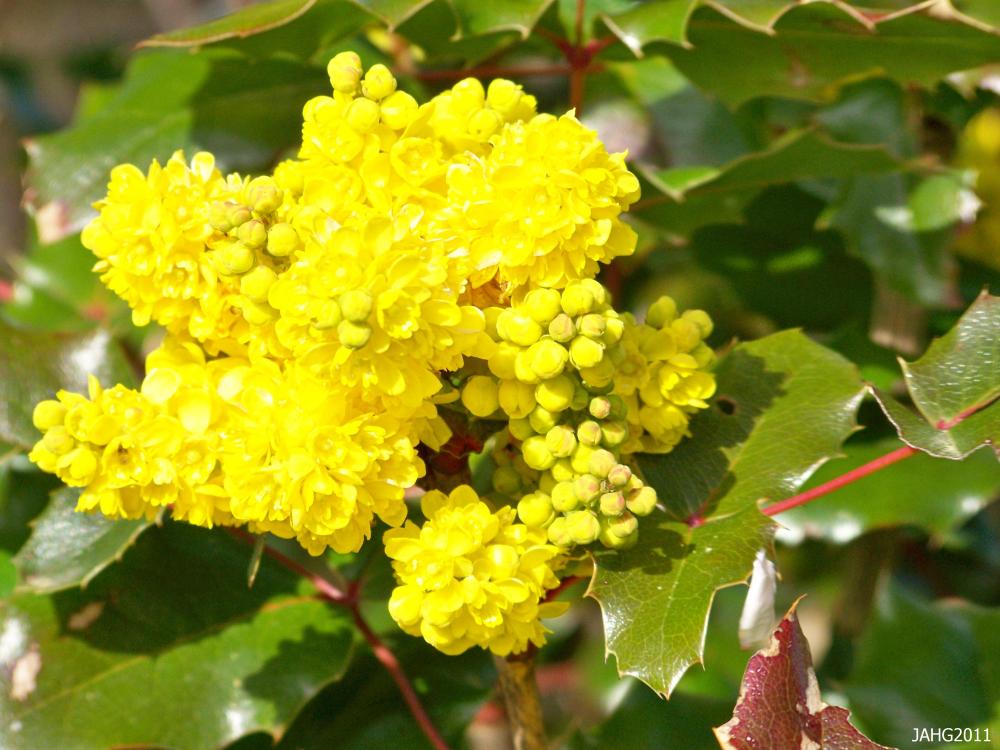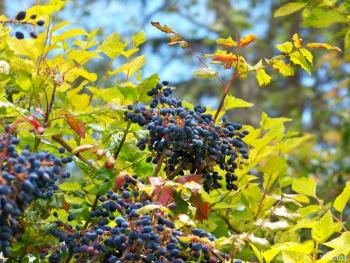OREGON GRAPE

Scientific Names
Mahonia Aquifolium (Tall), Mahonia Nervosa (Low)
Common Names
Tall Oregon Grape, Low Oregon Grape, Oregon hollygrape, Oregon grapeholly, and Holly-leaved barberry
The state flower of Oregon is the yellow flower of Oregon Grape, hence the name.
Hulkemel’em Names
Suni’ ulhp (Downriver/Island), Suliyulp (Upriver)
Family
Berberidaceae
Phenology
Bloom Period: April-May.
Ripening of Fruit: September-October.
Identification
Oregon Grape is an open branching evergreen shrub with a spreading to upright habitat that typically grows 3-10’ feet tall and 2-5’ feet wide. It is recognized for its subtly fragrant yellow flowers that bloom in April, and turn into edible blue-black berries in late summer. The berries grow in clusters and are similar in appearance to small grapes. Each leaflet is a tapering oval with spiny teeth along the edges. They are pinnately compound and are variable in colour from season to season. In the spring, new growth leaves are red-tinted and develop into a glossy dark green by summer. During the winter season, foliage displays a purplish hue and transitions into a burgundy-bronze tone by winter. Each leaf contains 5-9 leaflets with a single central vein. It is common for Mahonia Aquifolium to have shinier leaves than Mahonia Nervosa. The leaves attach to the slender trunks of the shrub in an alternating arrangement.

Cautions
Usage of Oregon Grape should be avoided during pregnancy and breast feeding. Excessive use can lead to diarrhea and kidney inflammation.
Current Distribution and Local Habitat
Oregon Grape is native to the pacific Northwest from British Columbia to Northern California. It is found predominately in rocky woods and coniferous forests. It grows best in conditions that aren’t exposed to dry soil or cold winter winds. It can be grown in full shade or sun, however, excessive exposure to sunlight can lead to foliage scorching. Optimum growth occurs in partially shaded, moist areas with good drainage. On the UVic campus, it is located in Bower Creek, Finnerty Ravine, Haro Woods, Garry Oak Meadows, Cunningham Woods, South Woods and Mystic Vale. Mystic Vale is the location I selected to steward and harvest Oregon Grape.
Ethnobotanical Uses
Many first nations communities would gather berries in mid-August and eat them directly off the bush despite their sour flavour. The berries were also traditionally mashed and dried into cakes by the southern Okanagan of Washington. Other nations mashed, boiled and combined them with other sweeter berries. Oregon grape berries are also known for their use as a laxative and the smaller leaves were boiled until tender for eating. Additionally, the bark and wood of the plant were used as a tonic and blood purifier by some of the First Peoples of British Columbia. A powerful tea was derived from the roots to benefit reproductive health and delivery of the placenta. Oregon grape root tea has been noted for improving digestion and absorption, its ability to act as a contraceptive, the treatment of gonorrhea and syphilis, and the relief of itchy red eyes and sore throats. The roots and bark of the stems yield a yellow dye, traditionally used to stain baskets.
By Zoe Kamis
References
Gibbon-Howard, J. A. (2011). Oregons “grape”. Name That Plant. Retrieved from https://namethatplant.wordpress.com/2011/04/11/oregons-grape/
Indigenous Research Partnerships. (n.d.). Oregon Grape. Faculty of Land and Food Systems. University of British Columbia. Retrieved from
http://lfs-indigenous.sites.olt.ubc.ca/plants/oregon-grape-tall-dull-and...
Missouri Botanical Garden. (n.d.). Retrieved from http://www.missouribotanicalgarden.org/PlantFinder/PlantFinderDetails.as...
Myers, V. R. (2017). Oregon grape growing profile. The Spruce. Retrieved from https://www.thespruce.com/oregon-grape-profile-3269178
Medicinal Herbs: Oregon Grape. (n.d.) Retrieved from
http://www.naturalmedicinalherbs.net/herbs/m/mahonia-aquifolium=oregon-g...
Project Status:
Year:
Associated Projects:
Image:

